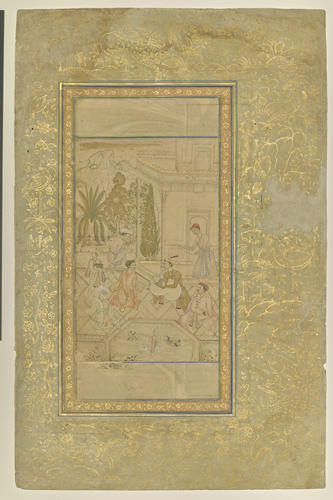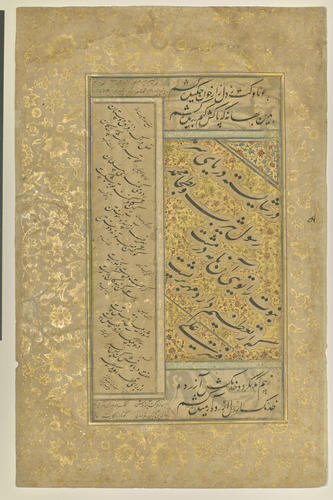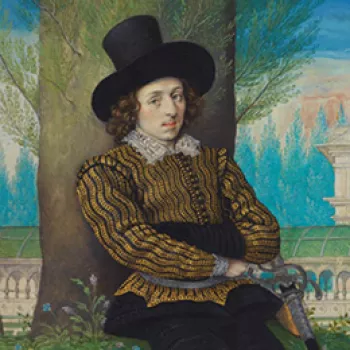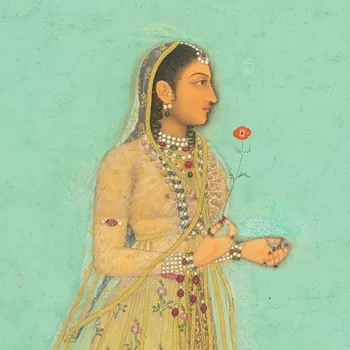Folio from a Mughal Album (painting by Lal; calligaphy by Mir Ali and Muhammad Husayn Kashmiri). 1590 - 1600
composite loose sheet from an album | 37.25 x 24.0 cm (page dimensions) | RCIN 1005039
-
23 folios from a Mughal album c.1600 containing Persian calligraphy specimens by Muhammad Husayn Kashmiri as well as the work of earlier master calligraphers and ink and wash paintings by Mughal painters. The borders are decorated with floral patterns, landscapes, birds and animals painted in gold pigment.
The folios entered the Royal Collection as unbound loose leaves, but Persian numerals written at the top-left corner of each recto and beneath the images indicate that the album originally contained as least 76 folios and 44 paintings.
The calligraphy specimens include texts by the following classical poets: Salman Savoji, Abu Said Abul-Khayr, Nizami, Sanai, Asadi Tusi, Farid al-Din Attar, Shaykh Abul Qasim Gurgani, Sadi, Rumi, Hafiz, Amir Khusrow, Baba Afzal Kashani, Jami, Baba Fagani, and Baba Talib Sepahani. These are mainly verses of Persian Sufi poetry or pious phrases. Most are in Persian, but some are in Chagatai Turkish and Arabic.
Most of the calligraphic texts are by the Mughal calligrapher Muhammad Husayn of Kashmir (active c.1580-1611), a celebrated master at the courts of emperors Akbar and Jahangir who compiled albums, wrote manuscripts (see also RCIN 1005022) and designed inscriptions to be transferred onto stone buildings. Many of his texts in this album are written on marbled, gold-flecked paper and on some of these the marbling has been traced with gold paint and painted with animal heads.
Other sheets of text compiled in the album are by celebrated fifteenth and early sixteenth-century master calligraphers of Iran and Central Asia including Sultan Ali Mashhadi (1453-1520) (see also RCINs 1005032 and 1005033), Mir Ali Heravi (d.c. 1550) (See also RCINs 1005019 and 1005068), and Sultan Muhammad Nur (d.c.1533-34 AD). Calligraphy specimens by such Timurid masters were collected by Mughal connoisseurs and emulated by leading contemporary calligraphers at the Mughal court.
The paintings in the album date to the second half of the seventeenth century and are ascribed to the Mughal artists Lal, Mukund, Dasvanth, Kesu, Dhanraj, Bhagvati and Bandi. The artists’ names are inscribed at the bottom of each image. These are third-person ascriptions rather than signatures, but most likely date to when the album was compiled. The subjects include princes and princesses reading poetry, holy men, an elephant hunt and scenes after European religious prints.
The paintings are distinctive in that they were drawn in a style that has subsequently been termed nim-rang (half-colour), an almost monochrome style of painting which may relate to the European printed books and engravings which circulated at the Mughal court. They are effectively line drawings, minimally coloured with light washes. Some of the colour pigments have changed over time. The brown-green areas are likely to contain a copper pigment, the original very pale green appearance of which has considerably darkened since application.
The illuminated borders are composed of two separate sheets of paper stuck back to back so that some folios have sides of different coloured borders: either pale brown or dyed blue or green. The gold designs of the borders are all unique comprising stylised blossoms and leaves, wild birds and fantastic beasts such as the Persian simurgh or Chinese qilin hunting prey.
In the gutters of the folios there is evidence of threads and earlier paper guards, some of which have an imprint of textile designs, which indicate that the folios were sewn together at some point. The pattern of which sides of the folio the paper guards sit on suggests that they were collated simply in pairs sewn together, rather than in larger gatherings.
Tide lines and off set ink indicate that the album suffered water damage while it was still collated, which may have been the reason for it its current state as individual folios. Two of the folios (RCINs 1005042 and 1005064) bear inscriptions in Persian: malik-i thomas sahib ('property of Mister Thomas'). The fact that these inscriptions exist only on two pages suggests that the folios were already separated by this point, i.e. when still in India.
This group of folios was traditionally housed in an 18th century folder also containing a page from a 17th century Mughal album (see RCINs 1005041 and 912081) inscribed amal-i Bakhtavar Khan ('property of Bhaktavar Khan') referring to an official at the court of Emperor Alamgir who received the title khan in 1659. A seal near this inscription gives a date of 1721. This folder may be identified as ‘A Book with some Indian Pictures’ in the Kensington List which was ‘deliver’d for her Majtys [Queen Caroline’s] use in ye year 1728’. Also housed within this folder were two folios of a 17th century Deccani albums (RCINs 1005050 and 1005065) and a later Mughal album (RCIN 1005066).
73 folios exist of what is likely to have been another similar, now dispersed, Mughal album of calligraphy, mostly by Muhammad Husayn Kashmiri (see Sotheby’s, 18 October 1995, lots 68, 90 and 91; Christie's, 17 April 2007, lots 211-5 and 218; and Sotheby’s, 27 October 2020, lot 425). The colours of the borders and the styles of illumination of this group of folios differ slightly to those in the Royal Collection. The 73 folios have a different numerical system and are in better condition, not having suffered water damage, when compared to the album in the Royal Collection.
1005039 Verso
Inscribed 'the work of Lal'
c.1590-1600
A painting of a Mughal prince and his attendants seated in a garden around an octagonal pool outside a pavilion. An open book held by the prince appears to be the topic of discussion and a kneeling scribe takes notes. A row of red palings separates the garden from trees and a rocky landscape.Lal was a senior artist working in the studio of the Mughal emperor Akbar who worked on all the major illustrated manuscripts produced during the 1580s and 1590s. See also RCINs 1005043 and 1005047.
RCIN 1005039 recto
Right:
A verse (two couplets) in praise of the Prophet Muhammad (a Nat)Necessary pearl of the Sea of Eternity
Messenger of Yathrib* and Batha**
To Prophecy you are him who clutches the Book
Who by his grandeur leaves the sun behind*another name for the Arabian city of Mecca
** an Arabian citySigned: 'The poor Ali'
Left:
Verse from The Conference of the Birds by Attar.
The intellect of perception, when separated from the Friend [God]
Is like an archer with a broken bow
Pour a full measure of old wine, O Muslim,
For this old infidel has broken his repentance:
It is proper to teach the Secret of the Invisible
To him who is able to sew his lips to refrain from talking
The seduction of Iblis* stems from your own deception
Each and every desire in you is your Iblis
Drink the Seven Seas** in your peregrinations
For the sake of a different drop in your voyage*Satan
** Scour the world
Signed: 'The poor, sinful slave, Muhammad Husayn. May God pardon him.'
Right Top and bottom:
An unidentified quatrain, unsigned:When I pull out of my heart your javelin dripping with blood
Under the pretext of cleaning it, I draw it to my eyes:
For fear that its point might become damaged
I calmly pull the point out of my damaged heart.
Left top and bottom:
Verses from a manuscript of Nizami's Khusraw and Shirin, unsigned:Alas! No one has enthusiasm
The eyes are blind and the world is full of sunshine
If you fulfil a desire of yours
A hundred Iblis* are burning in you
And goodbye!
And that’s the end of it!
*Satans
Three words give the date of the calligraphy in Arabic: ‘Written in the year 999’ (1590AD)
(Translations by Assadullah Souren Melikian-Chirvani)
Provenance
Likely acquired by George II before 1728.
-
Creator(s)
(calligrapher)(calligrapher)(nationality)(nationality)(artist) -
Medium and techniques
composite loose sheet from an album
Measurements
37.25 x 24.0 cm (page dimensions)
23.2 x 11.1 cm (panel)
17.3 x 11.1 cm (image)












